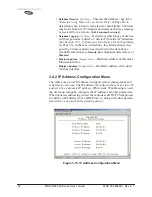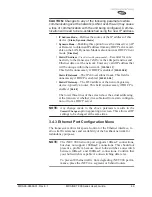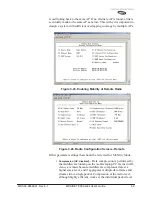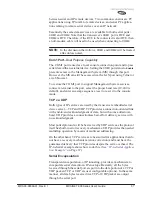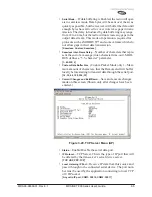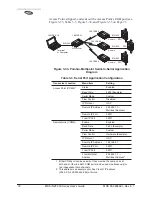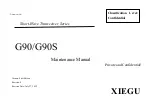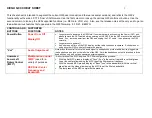
56
MDS iNET 900 Series User’s Guide
MDS 05-2806A01, Rev. E.1
•
Dwell Time
[
AP; 16.4 milliseconds
]—This setting controls the
amount of time that the unit spends on each frequency between
hops. Due to the varying conditions of a mobile environment,
this dwell time setting maximizes the benefits of frequency
diversity. Although overall throughput appears to decrease by
this setting, two benefits are gained: the effects of multipath fad-
ing are minimized through frequency diversity, and the com-
pression described above compensates for the decreased
throughput.
•
Beacon Period
[
AP; Fast
]—This parameter defines the interval at
which the Access Point transmits a synchronization beacon to
all remotes. This setting minimizes resynchronization times
when remote radios roam between access points or in highly
interrupted coverage areas (dense buildings, for example).
•
Fragmentation Threshold
[
remote; 256
]—This parameter defines
the size of the message packets transmitted over the wireless
media. These fragments are reconstructed into the original
packet before delivery to the external device at the remote end
of the link. In a mobile environment with rapidly changing con-
ditions, setting this value to a minimum value improves the
probability of packets being sent complete on the first try.
•
RTS Threshold
[
AP; 0 -1600 bytes
]—This setting is a wireless
equivalent to RTS/CTS flow control in a normal communica-
tions circuit. This mechanism removes packet collisions caused
by the “Hidden Node” scenario, in which remotes can’t hear
each other before transmitting. When this value is set below
100, it is essentially disabled.
•
Skip Zone Options
—In some instances there may be a part of the
spectrum used by another system, that results in “continuous” or
“persistent” interference to your system. To alleviate this form
of interference, the transceiver may be programmed to “block
out” affected portions of the spectrum using the Skip Zones
Menu. This menu is fully described on Page 51.
•
Auto Data Rate
—The transceiver’s Auto Data Rate feature can be
very helpful in mobile environments, where signal quality tends
to change rapidly. When signal quality is good, 512 kbps data
speed can be used. If signal quality degrades, the radio automat-
ically switches to 256 kbps. The criteria by which these speed
changes will occur is controlled by the parameter settings in the
Auto Data Rate Configuration submenu described on Page 52.
3.6
CONFIGURING THE SERIAL
INTERFACES
3.6.1 Overview
The transceiver includes an embedded serial device server that provides
transparent encapsulation over IP. In this capacity, it acts as a gateway
Summary of Contents for iNET 900 Series
Page 10: ...2 MDS iNET 900 Series User s Guide MDS 05 2806A01 Rev E 1 ...
Page 26: ...18 MDS iNET 900 Series User s Guide MDS 05 2806A01 Rev E 1 ...
Page 118: ...110 MDS iNET 900 Series User s Guide MDS 05 2806A01 Rev E 1 ...
Page 120: ...112 MDS iNET 900 Series User s Guide MDS 05 2806A01 Rev E 1 ...
Page 136: ...128 MDS iNET 900 Series User s Guide MDS 05 2806A01 Rev E 1 ...
Page 148: ...140 MDS iNET 900 Series User s Guide MDS 05 2806A01 Rev E 1 ...
Page 150: ...142 MDS iNET 900 Series User s Guide MDS 05 2806A01 Rev E 1 ...
Page 164: ...156 MDS iNET 900 Series User s Guide MDS 05 2806A01 Rev E 1 ...
Page 172: ...164 MDS iNET 900 Series User s Guide MDS 05 2806A01 Rev E 1 ...

